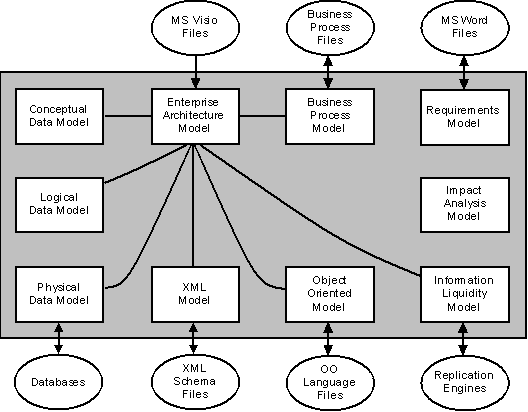An enterprise architecture model (EAM) helps you analyze and document your organization and its business functions, along with the applications and systems that support them and the physical architecture on which they are implemented.
Enterprise architecture modeling helps you to analyze and document the architecture of your organization. Such an analysis, can be required:
The diagrams in the PowerDesigner® enterprise architecture model are divided into three layers as follows:
-
Business Layer - helps you to analyze your organization in various ways:
-
Organization Charts – for documenting groups and people
-
Business Communication Diagram – for documenting sites and analyzing the interactions between various parts of your organization
-
Process Map – for documenting functions
-
City Planning Diagram - for providing a big picture, global view of the organization, and for descending to the system and database level, to provide links into the next, application layer.
-
-
Application Layer - descends into the applications, databases, and other systems that must implement the business functions identified in the business layer. The two diagrams in the application layer allow you to identify what applications you have, and how they interact with each other, in two different ways:
-
Technology Layer - models the hardware on which the software is deployed. If the business layer allows you to define what it is your organization does, and the application layer identifies the software that implements these functions, the technology layer documents the physical equipment on which the software will run. This layer has a single diagram:
Extending Your Analysis into Other Modules
The enterprise architecture model is intended to give you the big picture of your organization, and to provide means to decompose your functions, processes, and systems to a certain level of detail. However, when it comes time to model the implementation of databases, web services, or OO components, you will want to do this in the PowerDesigner module designed for the task.
The EAM contains wizards that allow you to import objects from and export objects to other PowerDesigner modules. Objects exported or imported remain linked to the original objects, in order to keep all your models synchronized and to allow you to perform cross-module impact analysis to identify the technical impact of changes on your enterprise architecture.
The following diagram illustrated how you can deepen the analysis of your architecture by linking your EA objects with lower-level objects in other types of PowerDesigner models:

Using Enterprise Architecture Frameworks
PowerDesigner projects enable you to easily combine multiple models and view the connections between them. You can follow an enterprise architecture framework such as FEAF by creating a project that combines your EAM diagrams with those of a Physical Data Model and other PowerDesigner modules.
For more information, see Creating an Enterprise Architecture Framework Project.
Suggested Bibliography
-
O'Rourke, Fishman, Selkow, Enterprise Architecture: Using the Zachman Framework, Thompson Course Technology, 2003, 716 pages, ISBN 0-619-06446-3.
-
David C. Hay, Morgan Kaufmann, Data Model Patterns: A Metadata Map, 2006, 406 pages, ISBN 0-12-088798-3.
The following online resources provide an introduction to enterprise architecture concepts: